Ch. 5-6: Soil Water Dynamics and Hydrologic Cycle in Soil Science
1/80
Earn XP
Description and Tags
Soil Science Exam 2 Ch. 5-6
Name | Mastery | Learn | Test | Matching | Spaced |
|---|
No study sessions yet.
81 Terms
Polarity
Has positive & negative sides.
Hydrogen bonding
+ attracts to − between water molecules.
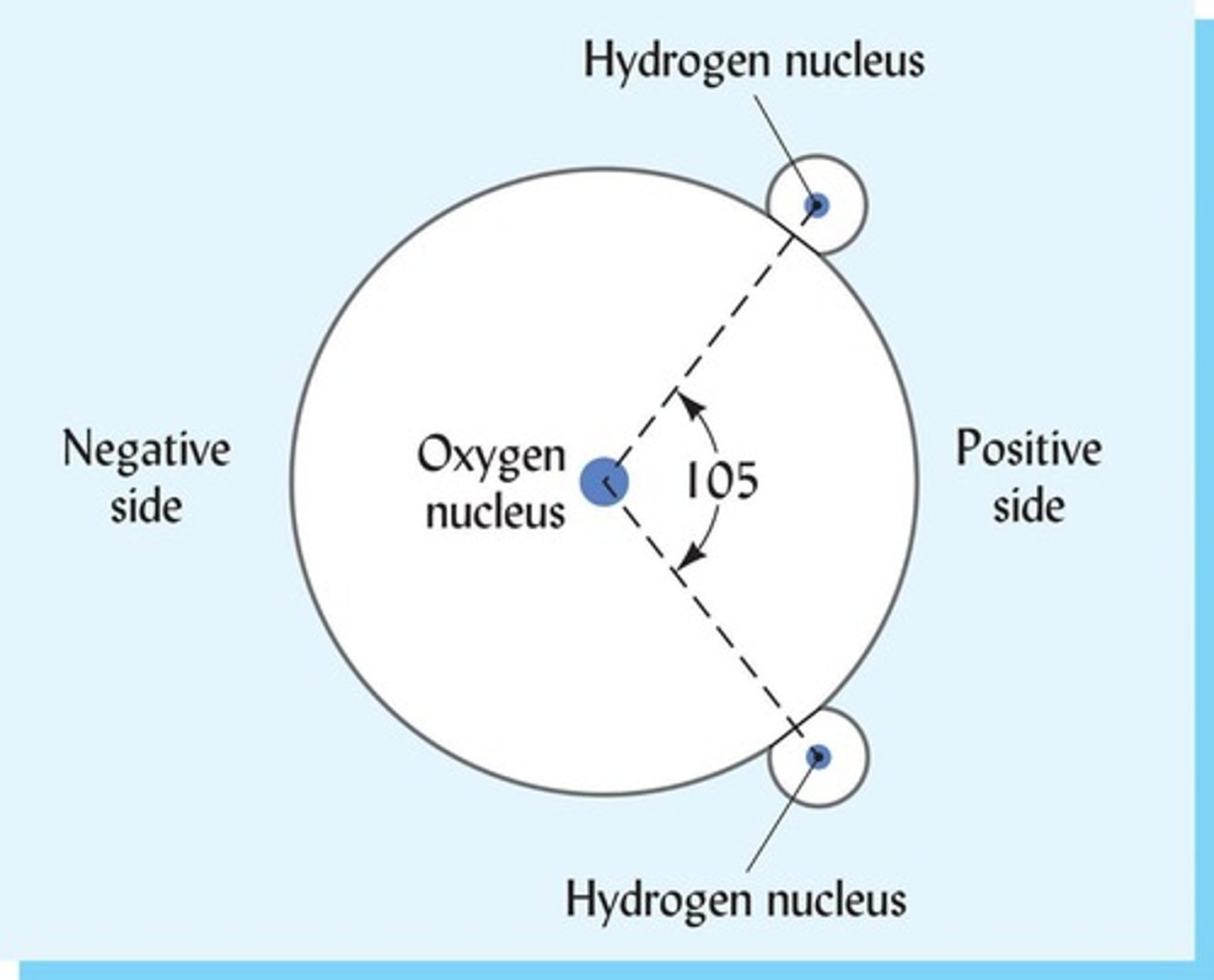
Hydration
Other molecules attracted to + or − sides of water.
Cohesion
Water attracted to water.
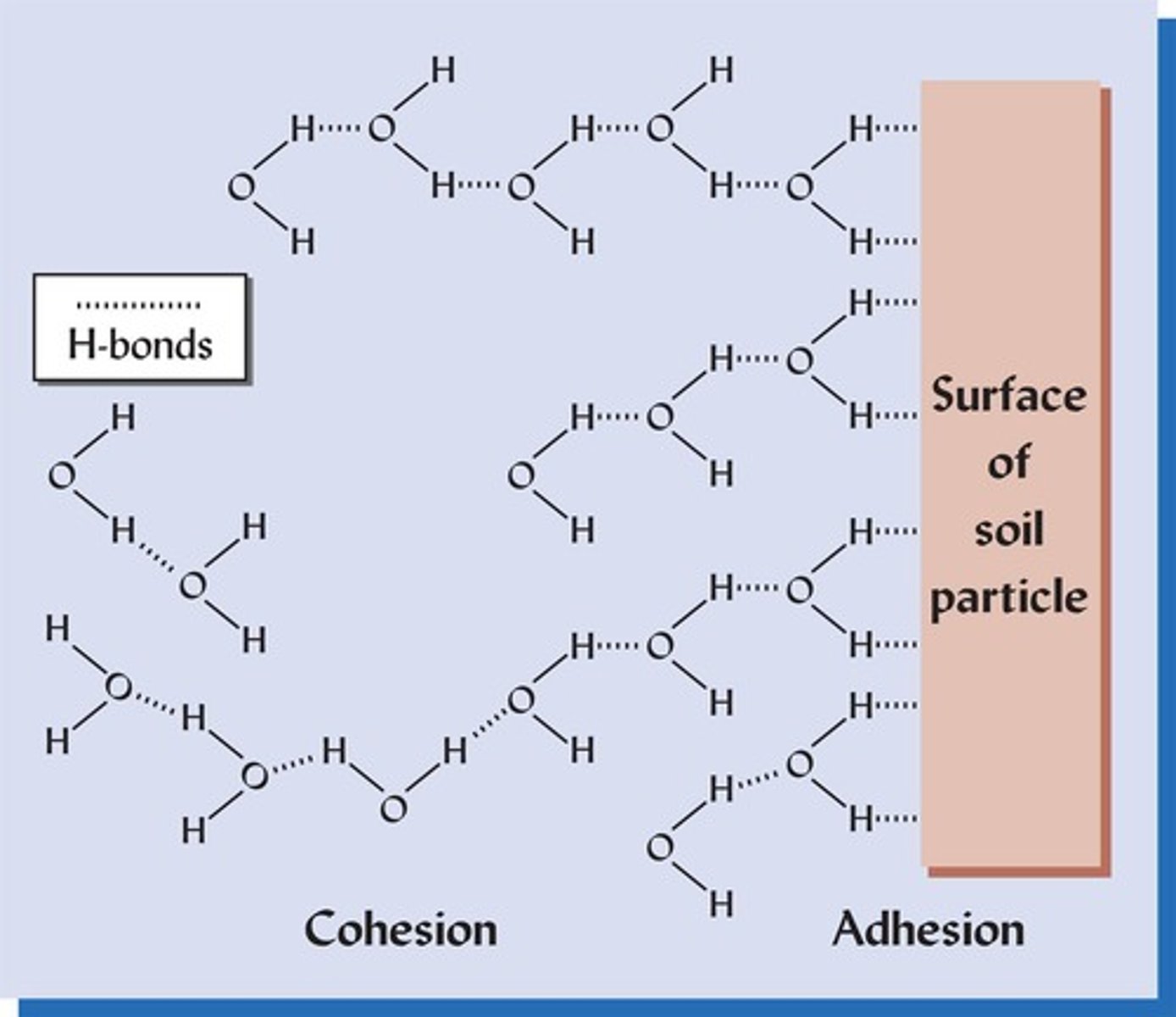
Adhesion
Water attracted to solids.
Surface tension
Attraction between water molecules (cohesion) is greater than attraction to air.
Capillarity
Phenomenon by which water moves in soil due to adhesion and cohesion.
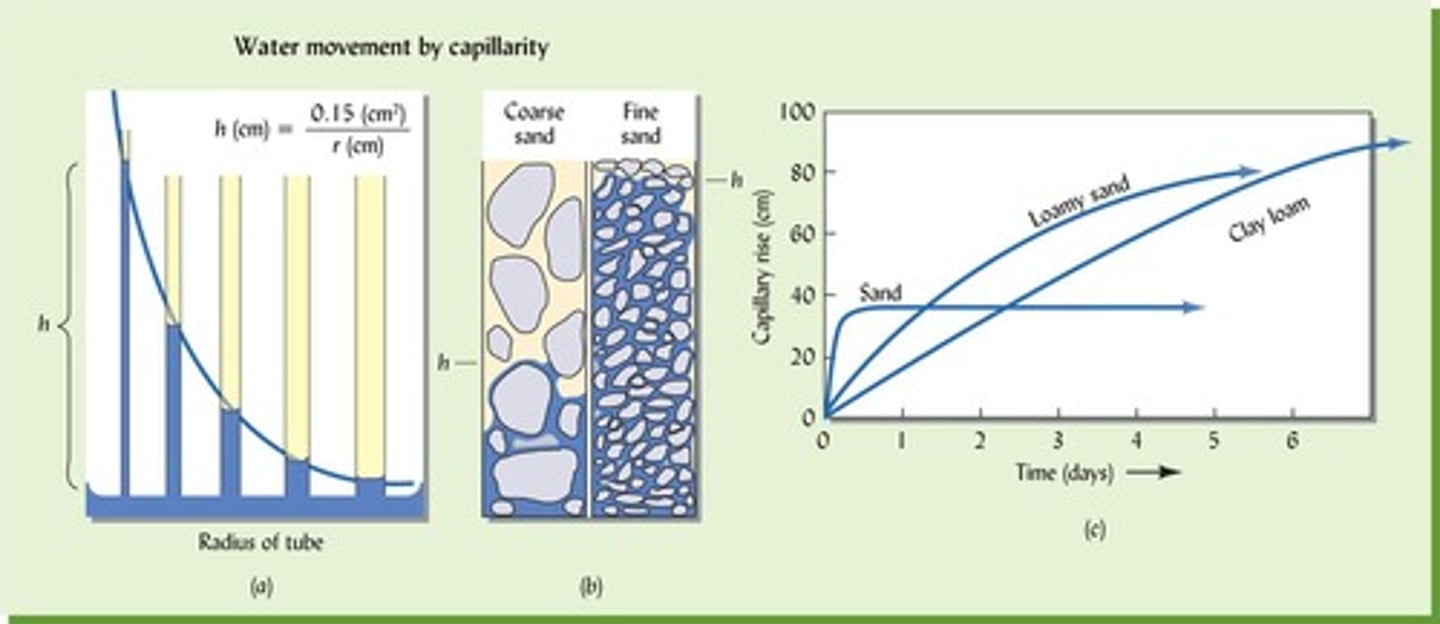
Gravimetric soil water content
The mass of water in a given mass of soil.
Volumetric soil water content
The volume of water in a given volume of soil.
Saturation
The state when all soil pores are filled with water.
Field capacity
The amount of soil moisture or water held in the soil after excess water has drained away.
Wilting coefficient
The soil moisture level at which plants can no longer extract water.
Hygroscopic coefficient
The amount of water held tightly to soil particles.
Gravitational water
Water that drains through soil under the influence of gravity.
Plant available water
Water that can be absorbed by plant roots.
Unavailable water
Water that is not accessible to plants.
Capillary water
Water held in the soil pores against the force of gravity.
Hygroscopic water
Water that is tightly bound to soil particles and unavailable to plants.
Available water holding capacity
The amount of water that can be stored in soil and made available to plants.
Soil water potential
The potential energy of water in the soil, affecting its movement.
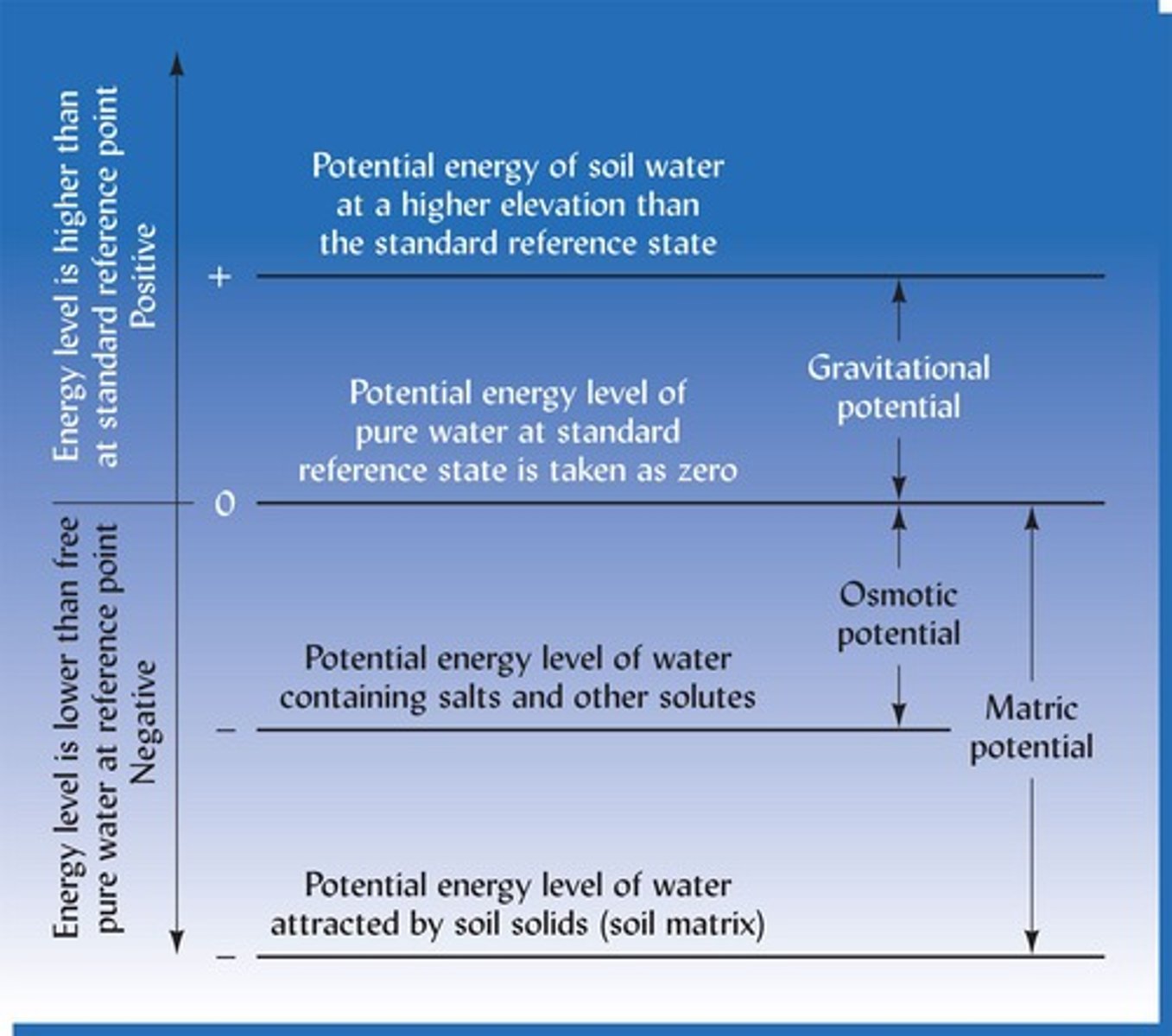
Matric potential
The potential energy associated with the attractive forces between water and soil particles.
Osmotic potential
The potential energy of water due to solute concentration.
Soil-plant-atmosphere continuum
The system describing the movement of water from soil to plants to the atmosphere.
Potential energy
Most important energy type in soils.
Soil water characteristic curves
Relationship between soil water potential (Ψ) and the amount of water in the soil, influenced by soil texture, structure, and pore size distribution.
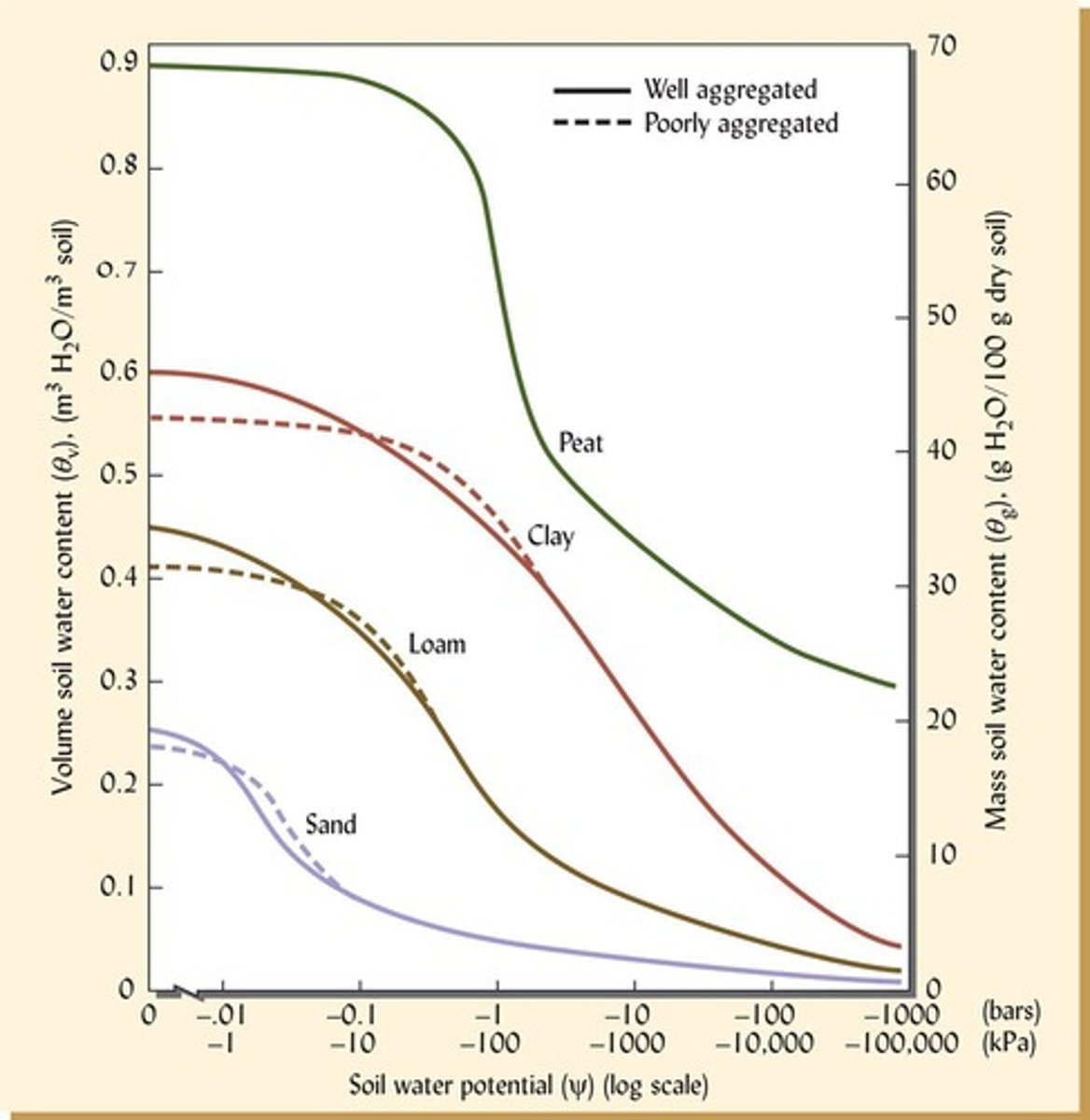
Gravimetric water content
θg = mass of water associated with a given mass of dry soil, calculated using oven-dried soil compared to sampled soil.
Volumetric water content
θv = volume of water associated with a given volume of dry soil; θv = Gravimetric water content (θg) × bulk density.
Soil water content
Amount of water in soil considered by mass (g/g) and by volume (cm3/cm3).
Energy state of water
Water moves to where its energy state will be lower.
Pore size distribution
Influences how soil water behaves and drains.
Water film thickness
Causes most of the pore space to be filled with water.
Soil texture
Influences the relationship between soil water potential and water content.
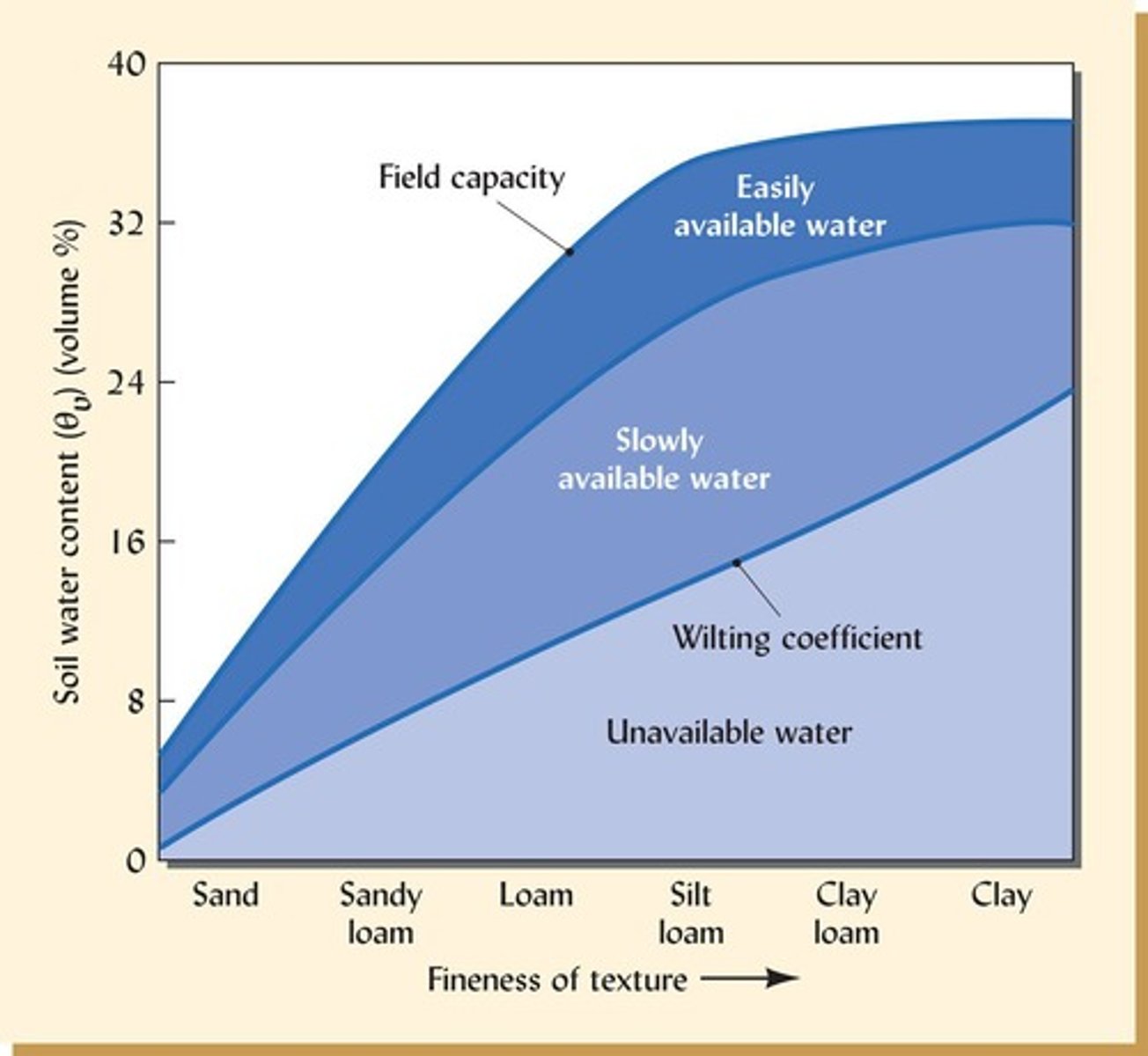
Soil structure
Influences the relationship between soil water potential and water content.
Water potential
Determines how soil water behaves and its supply to plants.
High energy areas
Areas where soil water is wetter.
Low energy areas
Areas where soil water is drier.
Gravitational Potential
Water moves from high potential energy to low potential energy.
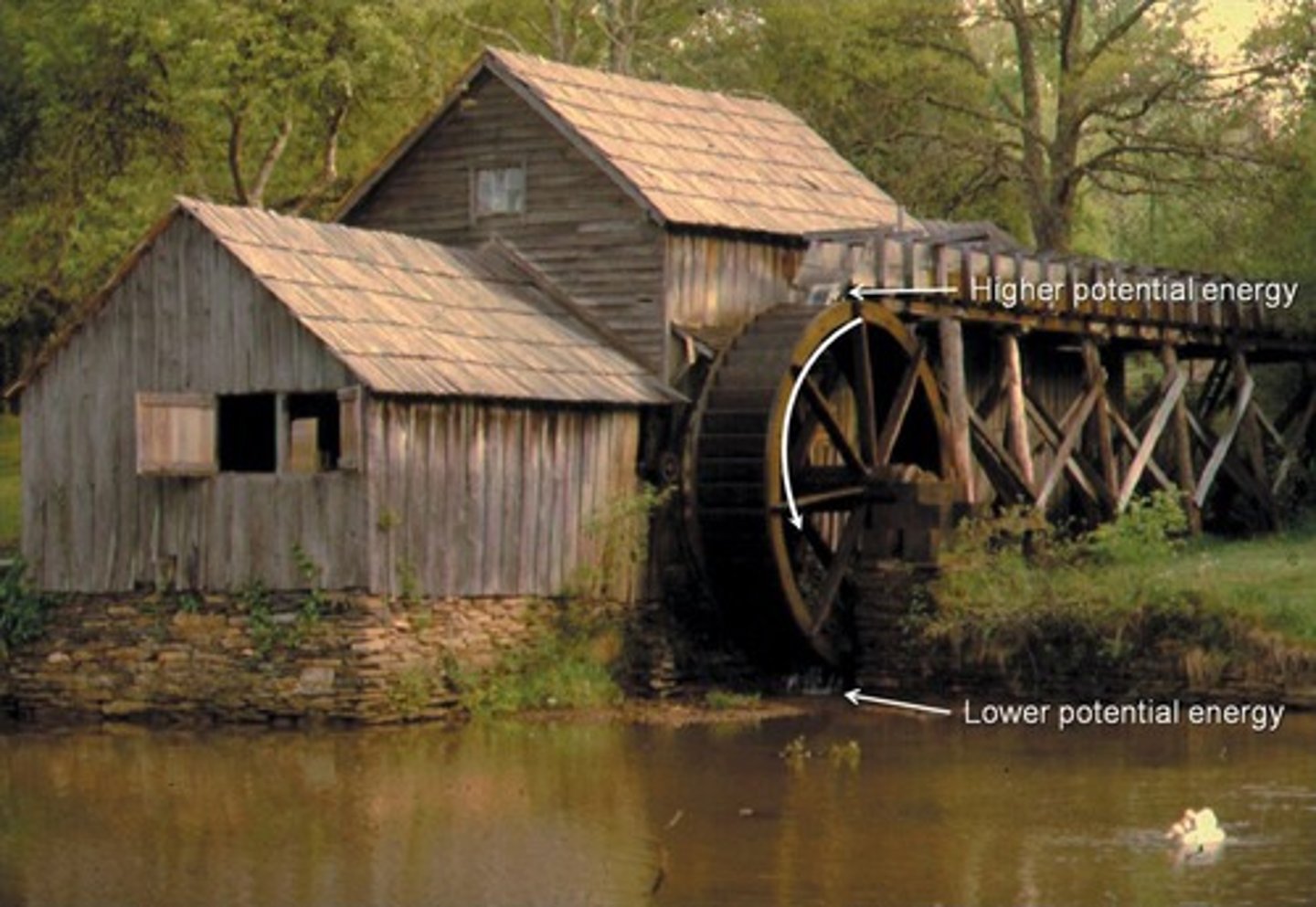
Soil water dynamics
Depends more on water potential (energy status) than on water content (amount).
Soil water supply
Longer-term supply depends on understanding both water potential and water content.
Negative pressure in soil
Caused by matric potential from attraction to soil solids.
Constraints in water uptake
Happen when osmotic potential in soil solution is lower than in the plant root.
Saturated
Maximum retentive capacity; all pore space filled with water; water in largest pores will drain down due to gravitational force.
Permanent Wilting percentage
Plants have removed all of the water that they can; soil water potential is about -1500 kPa; soil is very dry.
Above field capacity
Water is available but ventilation is limited.
At field capacity
Water, ventilation, physical support, root growth potential are optimum.
Below field capacity
Water begins to be less available; about ½ way to wilting coefficient water becomes slowly available.
Easily available
Water that plants can readily obtain.
Slowly available
Water that plants can obtain but at a slower rate.
Available water holding capacity (AWHC)
Difference between θg at field capacity and at wilting coefficient; how much water that can be held and is available to plants.
Global stocks of water
97% ocean water, 1.8% frozen, and 1.7% groundwater; most groundwater is > 750 m below the ground; 'Other water' = Just 0.02% of the total global stock.
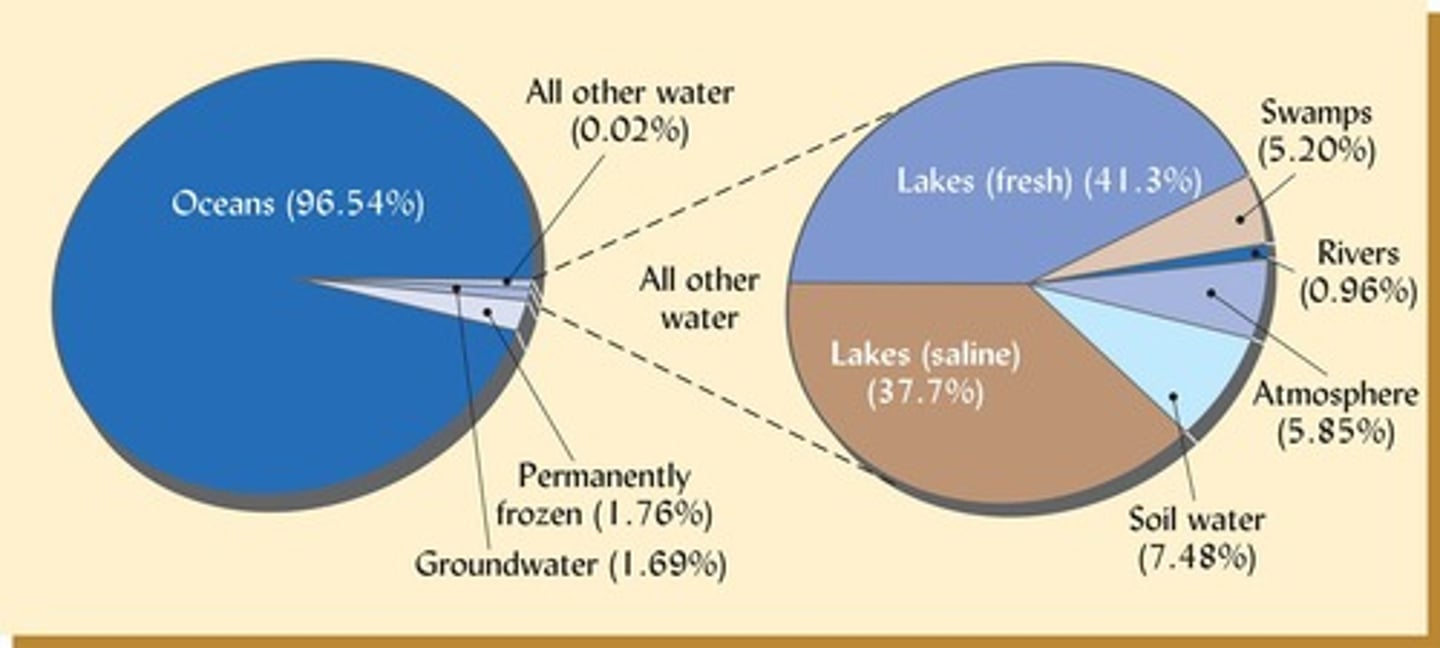
Water movement from Earth's surface
Atmosphere.
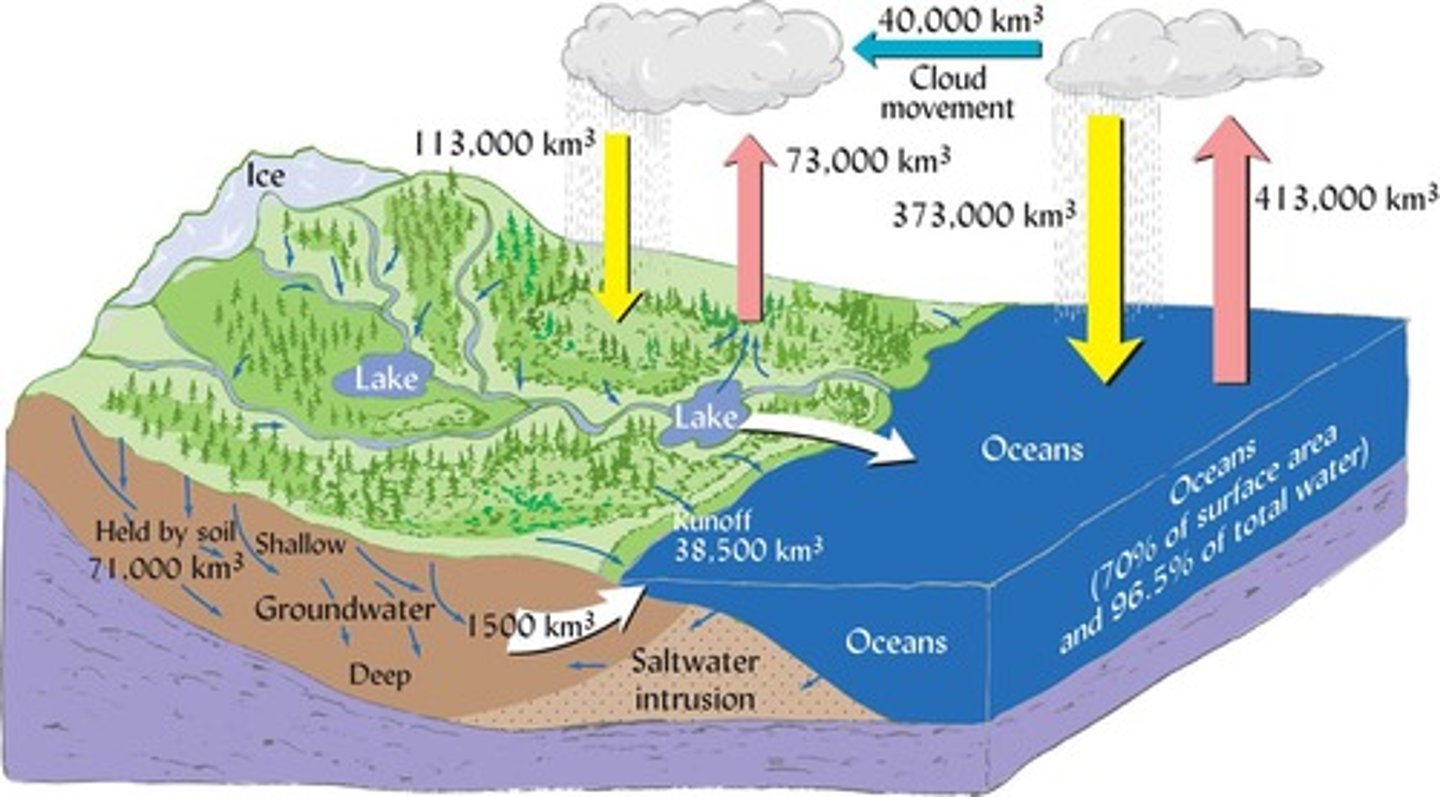
~65% of water falling to land
Becomes sorbed to soil particles at some point in cycle.
Soil-Plant-Atmosphere Continuum (SPAC)
Major component of hydrologic cycle; specifically examines water cycling between soil, plants, and atmosphere.
Movement governed by
Water potentials, rate of water supply to roots, plant transpiration rates.
Interception
Precipitation caught by plant foliage or litter layers
Returned to the atmosphere by evaporation
Does not reach the soil surface
Increases with higher temperature
Decreases with greater humidity and rainfall intensity.
Runoff
Water that reaches the soil surface may be lost as surface runoff; over 50% in extreme cases; carries dissolved chemicals, nutrients, soil particles/sediment.
Urban watersheds
Affected by compaction, destruction of soil structure, profile truncation, and impervious surfaces.
Ways of increasing infiltration
Permeable pavers, green roofs, vegetated street medians.
Infiltration
Process by which water enters soil pore spaces and becomes soil water.
Percolation
Once water infiltrates the soil, the water moves downward through the profile by percolation.
Soil storage water
Water retained by soil after infiltration/percolation, which eventually moves upward through capillary rise.
Evaporation
Occurs from the upper 15-25 cm of soil and is affected by temperature, soil moisture, and plant characteristics.
Transpiration
Specifically evaporation from plant foliage, requiring movement from the soil, into the root, and through the plant.
Evapotranspiration (ET)
Combination of evaporation (E) and transpiration (T).
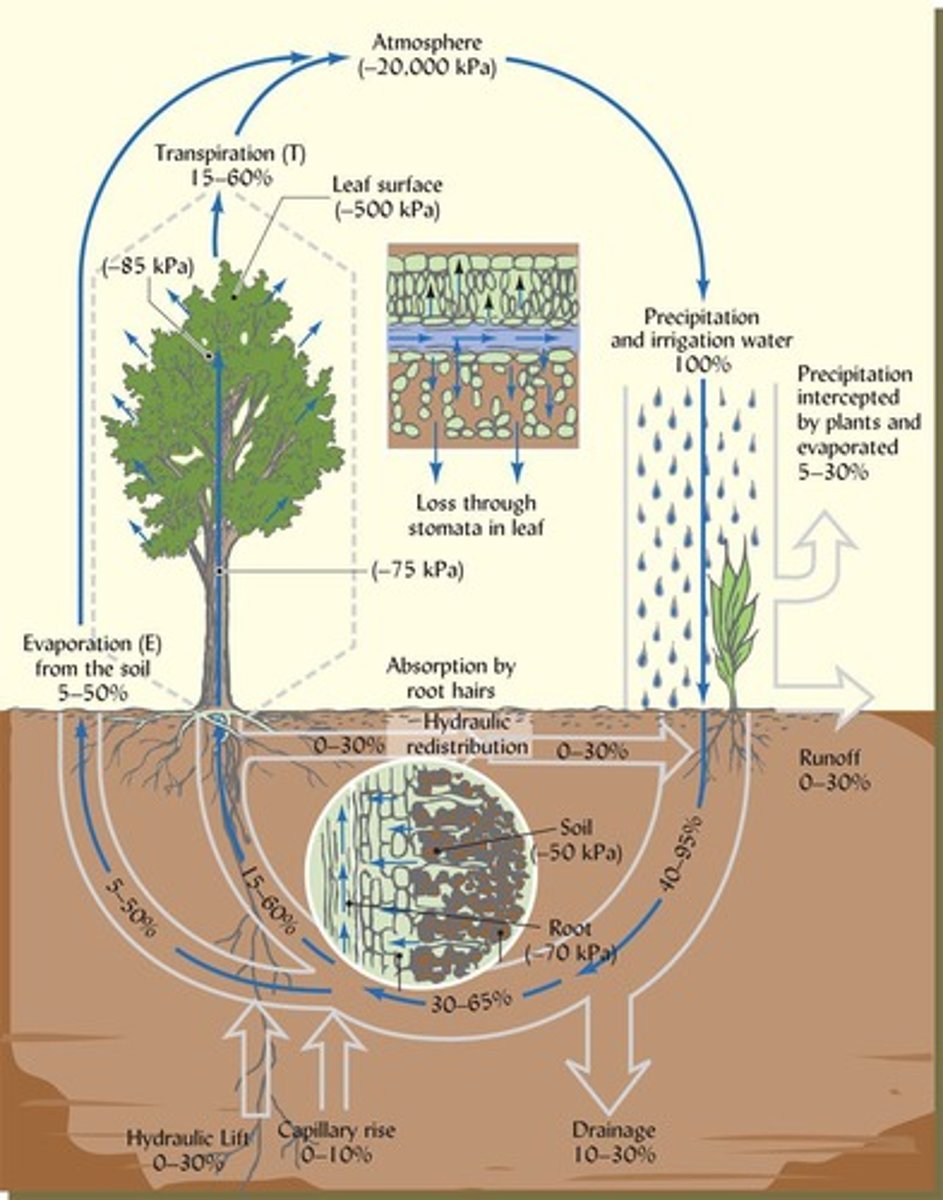
Potential Evapotranspiration (PET)
Rate at which water vapor is lost from a densely vegetated plant-soil system at an optimum soil water content.
PET formula
PET = 0.65 x Pan evaporation.
Surface Evaporation
Direct evaporation from soil surface, a large part of ET, especially in bare and wet surface soil.
Factors affecting Evaporation
Temperature, soil moisture, and plant characteristics (e.g., LAI).
Compaction
Influences runoff and infiltration by affecting soil structure.
Vegetation
Influences infiltration and runoff, with different types affecting water movement.
Soil properties
Affect infiltration and runoff, including texture and structure.
Capillary rise
Process by which water moves upward through soil.
Drainage
Occurs when water-holding capacity of soil is exceeded, leading to loss from the root zone.
Management practices
Include irrigation rate, furrows, cover crops, and controlling weeds to influence water movement.
Rain gardens
One method to increase infiltration and slow runoff in urbanized watersheds.
Permeable pavers
Another method to increase infiltration and slow runoff in urbanized watersheds.
Soil management
Practices that affect the infiltration rate and runoff, including tillage and crop residue management.
Hardpans
Soil layers that restrict water movement and increase runoff.
Biotic activity
Influences soil structure and water movement, including the role of earthworms.
Loose/open soils
Higher infiltration rates due to sandy texture and well-granulated structure.
Heavy/unstable soils
Higher runoff rates due to clayey texture and poor structure.